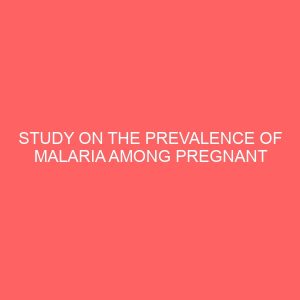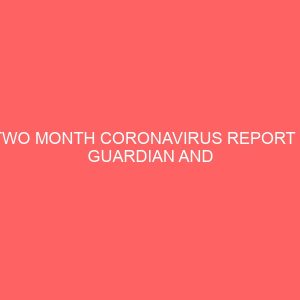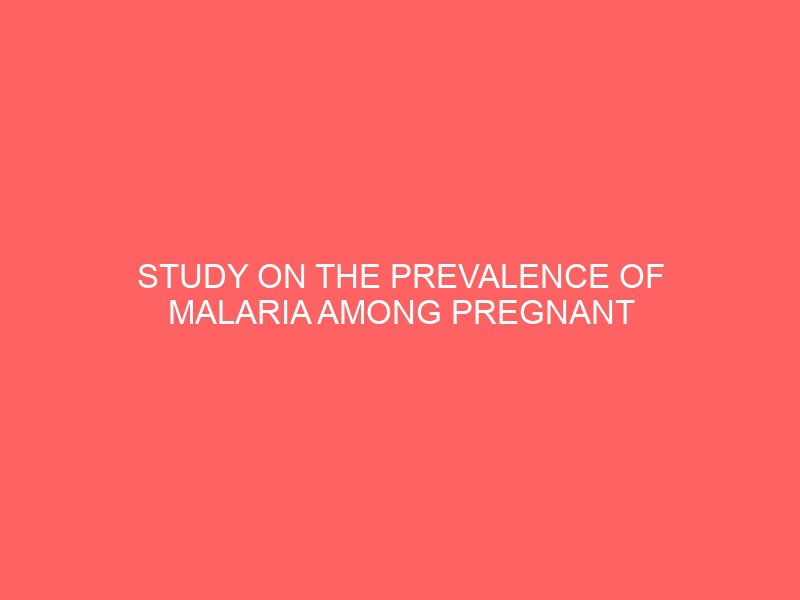Description
CHAPTER ONE
- INTRODUCTION
Malaria is an infections disease caused by a parasite, plasmodium which infects red blood cells. Historical records suggest that malaria has infected human since the beginning of mankind. The name “mal aria” (Meaning bad air in Italian) was first used in English in 1740 by H. Walpole when describing the disease. The term was shortened to malaria in 20th century. Laveran; in 1880 was the first to identify parasites in human blood. In 1889, Ross discovered that mosquitoes transmit malaria.
Malaria continues to be a cause of great suffering in tropical and sub-tropical regions of the world (Brabin, 1989). Currently, it is endemic in about 100 countries affecting 4% of world’s population. Malaria has been eliminated or effectively suppressed in several parts of the world in past decade but is now undergoing resurgence (Gilles, 1987). It is returning to areas from which it had been eradicated as well as spreading into new areas such as central Asia and Eastern Europe. Despite global economic development people are dying from malaria now than 30 years ago.
- EPIDEMIOLOGY AND CLINICAL FEATURES
Malaria in pregnancy remain a notable cause of maternal and prenatal morbidity and mortality, often associated with maternal illness, maternal anemia, low birth weight, preterm delivery and prenatal loss especially in the primigravidae. In semi-immune pregnant women, malaria infection may be asymptomatic, pregnant women are at risk of clinical disease compared to non-pregnant women at all levels of endemicity (Harrison, 1995). There is unparasitized blood cells leading to a greater level of anemia than can be explained on the basis of RBCS parasitization alone (who,1991).
Primgravidity is a known risk factor in pregnancy. It only becomes more prevalent in primigravide but also intense (Jimoh, 2003). The peak prevalence of parasitemia will be altered by prior anti malaria injection. In a study from Madan, Papua New Guinea, the peak prevalence in primigravidae studied reached 55% to compared to 86% in other study from Kenya (flemming, 1986). Studies have also suggested that the highest prevalence of infection occurs in the 2nd trimester with inflection rate at delivery and in the postnatal period approximating to levels in non pregnant women possibly due to immunity boosting during pregnancy (Akindele, et al 1993)
CAUSATIVE AGENT OF MALARIA
Malaria is caused by five (5) species of plasmodium. They are as follows:
plasmodium vivax (p. vivax) – This species is milder and generally not fatal. However, infected people still need treatment because their untreated progress can also cause a host of health problems. (Rogreson et al 2007)
Plasmodium Malariae ( P. Malaria) This species also is milder and not fatal. The infected person should be properly treated to avoid further health problems. This species is known to stay in the blood of the affected for several years (WHO, 2008).
Plasmodium Ovale (P. Ovale) – It is also mild and as well need adequate treatment to avoid serious health condition. It stays in the liver of the affected person even for years without symptoms. (Neeru, 2005)
Plasmodium Falciparum (P. Falciparum) This is the most serious form of the disease. It is most common in Africa, especially sub-saharan Africa. It needed thorough and adequate treatment of the affected person (Okwa, 2003).
Plasmodium knowlesi (P. Knowlesi). This causes malaria in macaques but can also infect humans.
INCUBATION PERIOD OF PLASMODIUM
This refers to how long it takes from initial infection to the appearance of symptoms. This generally depends on the type (species) of parasite.
- falicparum – 9 to 14 days
- P. Vivax – 12 to 18 days
- P. vivax – 12 to 18 days
- P. malaria – 18-40 days
However, incubation periods can vary from as little as 7 days to several months for P. vivax and p. ovale
SIGNS AND SYMPTOMS
The signs and symptoms of malaria typically begin 8-25 days following infections. However, symptoms may occur later in those who have taken antimalaria medication as prevention. The signs and symptoms may include the following
- Fever
- Shivering
- Joint pain (Arthralgia)
- Vomiting
- Hemolytic anemia
- Jaundice
- Convulsion
- Sudden coldness followed by rigor
- Severe headache
- Enlarged spleen etc.
LIFE CYCLE
The life cycle malaria is complex with asexual reproduction in the mammalian host and sexual reproduction in the anophelene vector. The female anopheles mosquito carrying malaria causing-parasites feeds on a human and injects the parasite in the form of sporozoites into the blood stream. The sporozoites travel to the liver and invade the liver. Within some days (5-6) the sporozites grow, divide and produce tens of thousands of merozoites. Some malaria parasite species remain dormant for extended periods in the liver. The merozoties exit the liver cells and re-enter blood stream to invade the red blood cell, it under goes asexual replication and release new formed merozoites from the red blood cells. Some of the merozoites infected blood cells instead of replicating asexually, develop into sexual forms of the parasite called male and female gametocytes that circulate in the blood stream.
When the mosquito has a blood meal, it ingests the gametocytes. In the gut, the infected human blood cell burst, releasing the gametocytes, which develop further into mature sex cell called gametes. Male and female gametes fuse to form ookinetes which burrow into the mosquito midgut and form outcasts. Growth and division of each oocyst produce thousands of active haploid forms called sporozoites which migrates to the salivary gland of the mosquito waiting for another round of blood meal (Ter kulie et al 2003)
PATHOGENESIS
During the life cycle of malaria parasites in human body, Mosquito infects a person by taking a blood meal. Initially, sporozoite enters the blood stream and migrate to the liver. They infect liver cells (hepatocytes); where they multiply into merozoites, rupture the liver cells and escape back into the blood stream. Then, the merozoites infect red blood cells, where they develop into ring forms, trophozoites and schizonts which in turn produce further merozoites. Sexual forms (gametocytes) are also produced, which if taken up by a mosquito, will infect the host and continue the life cycle. Malaria develop into too phases- exoerythrocytic and erythrocytic cycle/phases. Exoerythrocytic has to do with infection of hepatic or liver cells while erythrocytic phase entails infection of erythrocytes or red blood cell, the sporozite migrates to the liver and infects the hepatocytes. It can continue to multiply without showing any symptoms within 8-30 days (cogsnell, 1992).
EFFECT OF MALARIA INFECTION IN PREGNANCY
There are many adverse effects of malaria during pregnancy. Pregnant woman are known to be more prone to contracting malaria than those that are not pregnant. A women’s immune system is affected during pregnancy. He becomes much more susceptible to developing malaria which atime even leads to death of the child before birth or right after delivery (Steketee, et al, 2001). Some adverse effects of malaria during pregnancy include:-
- Anemia (Maternal and foetal aneinia)
- Fever
- Altered blood sugar levels
- Infection that harms the genitals
- Chance of cerebral malaria or other neurological problems
- Miscarriages
- Still birth
TREATMENT /MANAGEMENT OF MALARIA IN PREGNANCY
Treatment of malaria in pregnancy differs from the treatment of same woman outside pregnancy in several respects. Frequency and severity of infections are more in pregnancy particularly among primigravidae (Mutabingwa, 2004). Pregnant women with malaria infection must be treated both medically and obstetrically, taking care of both maternal and fetal interests. It is reasonable to expect confirmation of malaria infection in pregnancy. The choice of a suitable drug is predicated upon many factors including gestational age of fetus severity of the disease, the resistance of the infecting malaria parasites to the anti malaria drugs and safety profile of the drug in both mother and fetus. Ideally, effective care should clear both peripheral and placental parasites (Lars Hived, 1998).
OBSTETRIC MANAGEMENT OF PREGNANT WOMEN WITH MALARIA INFECTION
Obstetric management is an integral part of the complete management of the malarious pregnant women. It consists of antepartum, intrapartum and post partum care.
ANTEPARTUM CARE OF PREGNANT WOMEN WITH MALARIA
Essentially, during the antepartum or prenatal period, the antenatal clinic forms the template upon which the institutional treatment is based. As part of the routine ante natal care, history of malaria is obtained, blood tests including full blood count and malaria parasites are routinely requested for. Regular antenatal is of great importance as a single missed monthly clinic visit can result in a two fold increase malaria incidence. (Garnier, 1994) .
INTRA PARTUM MANAGEMENT OF MALARIA IN PREGNANCY
Intra partum management of parturient malarious women should include treatment of acute malaria with suitable agent. Routine intrapartum haemoglobin check is mandatory as ongoing hemolytic or pre-existing maternal anemia can substantially affect maternal and fetal outcome (Shulman et al, 1999).
POSTPARTUM MANAGEMENT OF MALARIA IN PREGNANCY
Following delivery, the mother should complete her antimalarials and supportive treatment. The foetus should be properly examined and congenital malaria excluded. The foetus should be properly examined and congenital malaria excluded. The newborn’s peripheral venous blood should be done to check for malaria parasites. Experiences by many authors have shown that heavy maternal parasitaemia significantly increases placental parasitization and fetal parasitaemia with consequent fetal anemia and possible fetal demise (Parise etal, 1998). The use of malaria vaccine in both the mother and the fetus postpartum is still inconclusive and controversial and many trials are underway to ascertain their safety profile and effectiveness.
PREVENTION/CONTROL OF MALARIA IN PREGNANCY
The main ways of preventing malaria in pregnancy can be achieved in two ways, they are;
- Avoiding mosquito bite:- This can be achieved in various ways.
- A) VECTOR CONTROL: This means trying to reduce contact with the vector of the disease. Controlling mosquito can significantly reduce malaria incidence as well as other mosquito borne diseases. Installation of screened windows air condition together with strategies to reduce vector populations are very effective and have led to the total elimination of malaria without completely getting rid of the mosquito (Neeru, 2005).
- B) USE OF INSECTICIDE TREATED BED NETS (ITNS): ITNS can reduce the incidence of malaria infection in pregnancy and also mortality rate in endemic areas. If ITNS are widely used in an endemic places, the mosquito population may drop dramatically as well as their life spans.
2) Preventing disease using anti malarial medications: Drugs that are effective and at the same time that cannot affect the growing foetus should be administered starting from early pregnancy. This type of prevention is also known as suppression, they do not prevent the parasite from entering the blood stream but they stop it from developing in the blood (mc cormick,1985)







